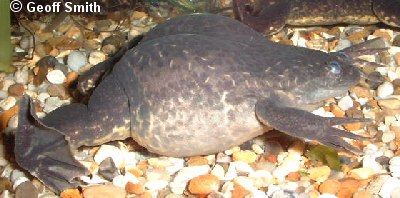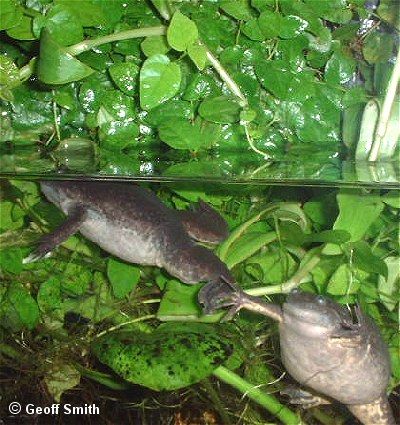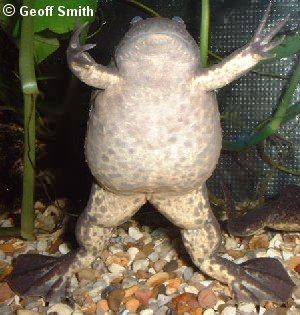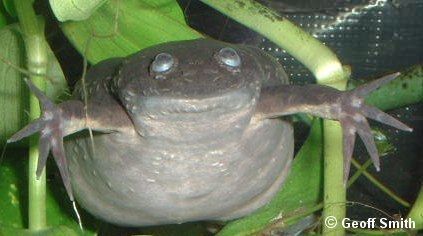The Care of African Clawed Frogs |
| An adult female Xenopus borealis. |
African clawed frogs (Xenopus spp.) are probably the easiest amphibians to care for. I kept them from 1983 to 2009 and this is a description of how I maintained them throughout most of those 26 years.
People have different opinions about filtration and, like most other things, there's never "only one right way" to do things. I've always maintained the frogs in tanks with undergravel filters without any problems. The tank below housed 5 x Xenopus borealis.

The tank is 36" long, 12" wide and 18" high (90cm x 30cm x 45cm). An under-gravel filter plate with one uplift tube covers the bottom of the tank and on top of the filter plate is approximately 2" (5cm) of gravel.
Attached to the top of the uplift tube is the pump from an Eheim 2209 internal power filter that is always submerged. It's important to use a reliable pump that is as silent as possible to avoid unduly disturbing the frogs.
A flexible hose is attached to the pump's outlet and trails along the back of the tank where it's connected to a submerged spray bar that has been cut in half.

The first half of the spray bar discharges water upwards against the back of the tank.
The second half of the spray bar is connected at right angles with a piece of flexible hose and it discharges water upwards against the side of the tank.

The purpose of having water discharge against the back and side of the tank is to absorb water turbulence that could otherwise distress the frogs. The frogs have sensory organs that detect movement in the water. The photograph below is of an adult female and the sensory organs resemble stitches along the frog's side.

At the end of the tank where the spray bars are, there is a large piece of petrified wood that serves to absorb the water current even more and provides refuge for the frogs to hide under.
 The depth of water from the tank bottom is 11" (28cm) (approx. 20 US gallons (76 litres)). This allows space for terrestrial plants to grow hydroponically above and below the water surface. This, again, absorbs the water current, provides refuge for the frogs, supports them when they float at the surface and, to some degree, serves as a biological filter.
The depth of water from the tank bottom is 11" (28cm) (approx. 20 US gallons (76 litres)). This allows space for terrestrial plants to grow hydroponically above and below the water surface. This, again, absorbs the water current, provides refuge for the frogs, supports them when they float at the surface and, to some degree, serves as a biological filter.
The main plant in the photographs is the Creeping Fig (Ficus pumila). Other plants are the Devil's Ivy (Scindapsus or "Pothos") and an entirely green form of Tradescantia. The only aquatic plant in the tank is Java Moss (Vesicularia dubyana).
The tank is illuminated for about 10 hours a day (via a time-switch) with an 18" (45cm) "Sunglo" tube. (This is mainly for the benefit of the plants and myself.)
The water is unheated and rarely rises above 70°F (21°C).
I change approximately 20% of the water every 2 weeks with tap water that has stood for about 24 hours for the chlorine to disperse. The replacement water is brought up to tank temperature with boiling water. The water's changed with a gravel cleaner attached to the syphon hose.
Finally, the frogs are usually fed once or twice a week on beef heart or ReptoMin pellets.

There is probably more information about African clawed frogs on the Internet than any other amphibian.
If you have any questions about African clawed frogs, or other aquatic frogs belonging to the frog family Pipidae, please visit the Pipidae Forum
at
pipidae.net.
To see more pictures, click on the frog below.

